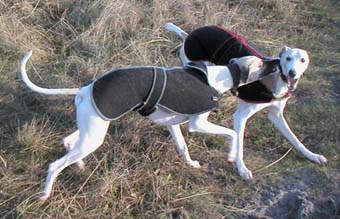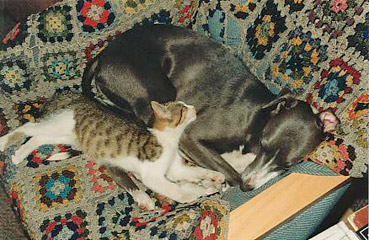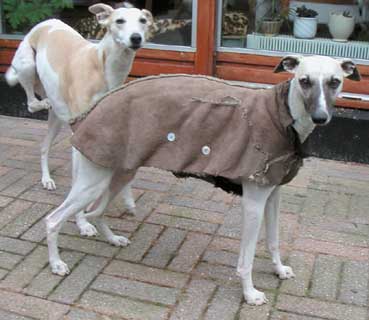
Question:
I am living in Norway. We have very cold winters here and I am wondering whether its wise to buy a whippet puppy. We have talked to some breeders who are very enthusiastic and advise that as long as they keep moving and have a coat on the coldest winter days that
they will not suffer.
Answer:
This is true. Whippets HATE the cold and even in a warm house and on the best chair or sofa, love to dive under a warm blanket - even in the summer! They also LOVE to sunbathe. However, there ARE many happy whippets living in Norway and Sweden, despite the cold!
Whippets have a very thin fur coat, (which has no "under coat" of softer fur for extra warmth), some are even quite bare on their stomachs and combine this with the fact that they have no fat layer, it stands to reason that they feel the cold more than many other dogs.
I have a variety of coats for the winter, from lightweight raincoats home-made from waterproof garden tablecloth material (!) that I use even in summer if we have to go out when it's just raining cats and dogs and cold too, (I like to go at the same time every day and they HATE to get soaked), through to "back- warmers" wool-cloth ones (seen above) that I use most of the Danish winter, to animal skin coats I have sewn myself with "tummy pieces" too, so they are completely wrapped up - with the suede side out and the furry inside for when it is many minus degrees of frost. These are not actually waterproof but can hold off the wet or snow for a good 1 1/2 hours walk.
These I use when it's minus degrees, or light frost made colder by a hard winds. They look like "stoneage/flintstone dogs" in these, and funnily enough, never attempt to ruin them in rough play. I illustrate one above which has been torn by many escapades chasing into thorn bushes in the dunes!
Or get this wonderful track suit that keeps legs warm:
http://togsfordogs.net
There is one worry though: their feet - when it's as cold as minus 12 degrees, their poor feet start to freeze and they MUST keep moving! Special dog shoes may be a must have?
Just walking them would not be enough - they need to run free.
I don't know how far up Norway you are or your climate, but you will have to look into this.
If there are MONTHS of extreme cold (worse than minus 5-7 degrees) - it WILL be difficult to exercise them well.
If just for short periods - well maybe you'll manage ok.
Second question:
Is it unkind to buy only one pup. We probably need to start with one pup as our much loved Norwegian Forest cat might find two puppies overwhelming. He is not used to dogs. I notice that most whippets seem to be in pairs.
Answer:
I strongly recommend getting one dog at a time but getting a second after say about a year.
The reason why they are often several, is because after the first wild flush of youth, they settle down to be such "easy" dogs that people want a bit more excitement with several!
Two dogs exercise and entertain each other every day - which is another big advantage.
The dogs LOVE to be several - 2 is by far the easiest number especially if one takes them out and about, and one is just as tied down by one dog as with two. Just keep to the same sex and you'll have no problems.
Dogs go very much up in "dominance" and who is alpha dog and their internal rank order, and if one introduces a new puppy to an older dog, things will go very well as a rule, as the puppy will always defer to the older dog, who will reign supreme with the minumum of "corrections" and displays of power toward the pup.
But dominance problems can very easily come for those who get 2 pups at once. These two may NEVER decide who is boss and decides over who in rank order, due to being the same age and this leads to fights and sometimes, when the dogs are adult it can go VERY badly wrong and certainly can be an unpleasant daily nightmare for the owners. Here, neutering them both can help.
So long as there's a year or more between the dogs, they usually can figure it out to everyone's satisfaction. Of course the younger one tries to challenge the older as it grows up, but usually an older dog knows how to deal with this!
Having said that, I have to be honest, I do know several people where it's gone just FINE having 2 pups at once, but still it is a situation best avoided.
Another important point: It is also FAR easier to train a single puppy then when one has two or more.
For your cat's sake, a dog who's under 6 months and preferably as young as possible, would be best.
Let them meet with puppy on lead and let the cat if necessary show it's claws in no uncertain way!
No amount of correction and telling off by you can replace the teaching of just one short spitting and clawing cat session!!!
The cat should have plenty of "easy get-away" places and high up places to sit watching puppy in safety etc. The cat should be "king" and the puppy learn that it's place is at the lowest rank under the cat!!!
If, as and when the cat feels his superiority is respected at all times (and whippets are often whimps if there's pain involved!) you will find they can have the most wonderful relationship which is great fun for your family to experience.
But it is important for the cat to feel safe and "in charge" of the situation.
The younger the puppy, the easier it is for the cat to have gain confidence at the start.
But be prepared: The cat will inevitably HATE the pup on sight at first!
There are always exceptions to the rule but I would be very surprised if your cat didn't loathe the pup on sight and run off!!!! This is every cat's automatic reaction! Don't give up or let this put you off.
Cats have a natural aversion to dogs and it's pretty well mutual, as dogs see them as prey to be chased. They have been rivals for our affection for thousands of years and their mentalities are so very different. (Though Sighthounds are very similar to cats in many ways - seen through our eyes, but ask the cat and he would say "it's still a DOG!!!")
BUT, both are capable of learning, and can and will see in time that both are "here to stay" and the problem cat/dog must be dealt with. A good "working relationship " can and WILL develop!
You just have to have patience.
However, always be aware of the fact that Whippets and all other sighthounds are born cat-killers and any strange cats, like the neighbour's cat etc - can and will be killed if the oportunity arises, even while they respect and even sleep cuddled up with "their own" cats.

Photo: Susanne Møller "Nan and Stoffer".
Third question:
Although I only work part-time we would at times need to let the dog be alone for a few hours. Do you think this would be cruel. I am at home a fair amount most days and would spend a lot of time with the dog and might be able to take it to my psychotherapy office, (most klients would accept this) when the dog was old enough.
Answer:
The dog must LEARN to be left alone in slow stages. If taught carefully and properly, they do not mind at all. You can read my advice about this from one of my pages found at the bottom of the list.
Start by never leaving it alone for say a week, to get it settled in. Let it sleep beside your bed in its own warm "beduin tent arrangement" that is garanteed to be "sweating hot like a sauna", and you'll have no trouble! Whippets love to be IN their owners beds but my husband and I are agreed we don't want this for many reasons, especially as we have 4 dogs, and have found that offering a super-warm-cosy "den" or "cave" of blankets BESIDE the bed is just fine. Warmth is the essence. Start by letting it follow you everywhere, even in the bathroom!!!
Then start to train by closing the door for a while and teach that you always return, even when you leave it in another room for a moment.
I always say "wait!" or "wait a minute!" to my dogs. Find some good commands about leaving the dog so it gets a verbal reminder of what is to happen. At first it will not like you closing the door on it for a few minutes but after a while it will learn that this is ok.
Then when the dog has thoroughly settled in and can tolerate that you disappear to other rooms without it, you can progress to leaving the house for 10 - 20 mins or so, if possible listening for if it whines. (I can tell you later what we do if any whining!)
Always leave it after a good walk/run around so it is inclined to sleep, together with a VERY warm bed arrangement with some chew toys some lively puppies like a branch of a tree to destroy! (Whippet puppies can be very destructive in their first year (some more than others) - not intentionally so, but in their constant seeking for new toys and chewey things and of course especially whilst cutting their teeth at 4-6 months! - I can give you some good ideas for cheap homemade toys, otherwise you can spend a fortune - which you probably will anyway!!! - but to start with, they need a lot of things to keep them off your own posessions! Every time I find a "wrong thing" in my puppy's mouth I shove in a dog toy instead!!!)
When we leave home, we sprinkle around the floor, a handful of puppy food (small particles) as we have a glass door and the actual moment where we walk away IS painful for the dogs, so we assure that they are all busy finding the tiny pieces whilst we lock and go quickly.
Always leave the dog as if you are going to a funeral - never like you are going to have fun without it!!! Say right at the start that it is staying behind and keep a very calm boring atmosphere around getting ready. Over a period of several weeks, never pressing the dog more than it will comfortably tolerate without protest, you can teach the dog to stay at home for longer and longer periods and it will neither destroy the place or whimper and bark. (Never let any dog have the run of the whole the house. Confine them somewhere cosy and smallish. They are, after all, not supposed to run around playing wild games but will learn to sleep more or less the whole time you are gone.
Question:
We (my husband and 13 year old daughter) think they are lovely adorable dogs but wouldn't choose a whippet if it will be unhappy in our situation.
Answer:
Your daughter is the perfect age for whippet (assistant) ownership and will be able to help by feeding or walking it occasionally and generally helping if you or your husband are late home or out somewhere. Whippets can, whilst on the lead, take off very suddenly at 90 miles an hour if they see something they want to chase. (Hence the tradition for wide collars, so they don't hang themselves!) They are deceptively demure, sedate and cute MOST of the time, so people think that even a 5 year old can walk them - but alas, so they can, but only until the moment when the dog sees a cat running down the street or anything that appears to be a fast moving "prey" and you need to be of a certain size and weight to be able to withstand the enormous pressure on arm and shoulder just for a few seconds until one gains control again!!!
But a 13 year old can command and get obedience when the situation needs it, whereas younger children cannot get the dog's respect! I'm sure your daughter will absolutely fall in love with a whippet and opposite! They are just so SWEET and clean and only want to please their owners, so they are easy to train - JUST SO LONG as they don't see something that appears to be "prey" moving fast when outside!
Both sexes are equally to be recommended. Males are much bigger - and bolder. And a tiny bit more "wayward".
Most people have a preference for one or the other sex, so I'd need to know more about you to be able to recommend which you should have! But maybe you already know?
If anybody has any further questions regarding the above, or wants to discuss things in greater depth, you are welcome to mail to me at:
janetfm@sighthound.net
|


